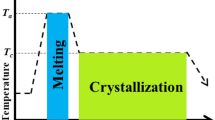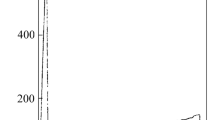Summary
The uniaxial deformation of single and multilayered crystals of polyoxymethylene was carried out and found that preference direction for crack formation was normal to the direction of drawing. The cracks are found to open very little on crystal well adhering to substrate while relatively more on the upper layer of multilayered crystals. Multilayered crystals, formed either by stacking of lamellae or from screw dislocation mechanism show similar behaviour of deformation. From the various results, it has been revealed that predominant mode of deformation of crystals involve combination of micronecking, “brittle” fracture of lamellae and formation of fibers, buckling in draw direction and shear along slip line. The development of mosaic structure in deformed crystals can be attributed to the result of cooperative micronecking and slip. The slip lines developed over POM crystals are always straight and parallel to growth faces irrespective of draw directions. Some of the characteristic features observed during the deformation are formation of (i) buckles parallel to draw direction, (ii) β-fibers which can be considered as highly deformed stage of lamella, (iii) fibers having “beaded” structure and (iv) a fiber by coalescence of fibers coming from different lamellae or from same lamella. A probable mechanism of formation of an artifact during the replicating process which appears as thinning of lamellae due to molecular tilting is advanced. Utilization of sodium carboxy Methyl Amylose in the replication process proved to be advantageous and in fact, most of the micro details of deformed crystals are retained even at a higher magnification.
Zusammenfassung
Die uniaxiale Deformation von Einkristallen und von Mehrschichtkristallen von Polyoxymethylen (POM) wurde ausgeführt und dabei gefunden, daß die Richtung senkrecht zum Zug für eine Rißbildung bevorzugt ist. Die Risse öffnen sich sehr wenig an Kristallen, die gut an der Unterlage haften, dagegen relativ stärker an den oberen Schichten von Mehrschichtkristallen. Mehrschichtkristalle, gebildet entweder aus der Stapelung von Lamellen oder mittels Schraubendislokationswachstum, zeigen einander ähnliches Deformationsverhalten. Aus den verschiedenen Ergebnissen läßt sich erkennen, daß die vorherrschende Art der Deformation von Kristallen eine Kombination umschließt von Mikronecking (Mikroeinschnürungen), Sprödbruch der Lamelle und Bildung von Fasern, Kippen in der Verstreckrichtung und Scherung längs Gleitlinien. Das Auftreten von Mosaikstrukturen bei deformierten Kristallen kann als Ergebnis einem kooperativen Mikronecking und Gleiten zugeschrieben werden. Die Gleitlinien entwickeln sich bei POM-Kristallen immer senkrecht und parallel zu den Wachstumsflächen in Bezug auf die Zugrichtungen. Einige der charakteristischen Züge, die während der Deformation beobachtet werden, sind die Bildung von Falten parallel zur Zugrichtung, zweitens von β-Fasern, welche als hochdeformierte Zustände von Lamellen betrachtet werden können, drittens von Fasern mit einer Perlenstruktur und viertens die Ausbildung einer Faser durch Zusammenfließen von Fasern aus verschiedenen oder auch derselben Lamelle. Ein wahrscheinlicher Mechanismus der Bildung von Artifakten während des Abdruckprozesses, der ein Dünnwerden einer Lamelle durch molekulares Abkippen zu sein scheint, wird vorgeschlagen. Die Verwendung von Natriumcarboxy-methyl-amylose im Abdruckprozeß scheint vorteilhaft zu sein und in der Tat bleiben die Natriumcarboxy-methyl-amylose im Abdruckprozeß scheint vorteilhaft zu sein und in der Tat bleiben die meisten Mikrodetails der deformierten Kristalle sogar bei höherer Vergrößerung erhalten.
Similar content being viewed by others
References
Aggarwal, S. L., G. P. Tilley, andO. J. Sweeting, J. Appl. Polymer Sci.1, 91 (1959).
Ingram, P. andA. Peterlin, J. Polymer Sci.B2, 739 (1964).
Kasai, N. andM. Kakudo, J. Polymer Sci.A2, 1955 (1964).
Peterlin, A., P. Ingram, andH. Kiho, Makromol. Chem.86, 294 (1965).
Hay, I. L. andA. Keller, Kolloid-Z. u. Z. Polymere204, 43 (1965).
Kobayashi, K. andT. Nagasawa, J. Polymer Sci.C15,163 (1966).
Stein, R. S., J. Polymer Sci.C15, 185 (1966).
Sakaoku, K. andA. Peterlin, Makromol. Chem.108,234 (1967).
O'Leary, K. J. andP. H. Geil, Makromol. Chem.118,77 (1968).
Sakaoku, K. andA. Peterlin, J. Polymer Sci. A-2,9,895 (1971).
Sakaoku, K. andA. Peterlin, Makromol. Chem.157,131 (1972).
Geil, P. H., Polymer Single Crystals (New York 1963).
Geil, P. H., J. Polymer. Sci.A-2, 3813, 3835, 3857 (1964).
Peterlin, A., J. Polymer Sci.C9, 61 (1965),C15, 427 (1966),C18, 123 (1967).
Kiho, H., A. Peterlin, andP. H. Geil, J. Polymer Sci.B3, 157 (1965),B3, 257 (1965),B3, 263 (1965).
Ingram, P., H. Kiho, andA. Peterlin, J. Polymer Sci.C16, 1857 (1967).
Klement, J. J. andP. H. Geil, J. Polymer Sci. A-2,7,1381 (1968).
Garber, C. A. andP. H. Geil, Makromol. Chem.113,251 (1968).
Woodward, A. E. andD. R. Morrow, J. Polymer Sci., A-2,7, 1651 (1969).
Yeh, G. S. Y. andP. H. Geil, J. Macromol. Sci. (Phys.),B2, 29 (1968).
O'Leary, K. J. andP. H. Geil, J. Macromol. Sci. (Phys.),B2, 261 (1968).
Sakaoku, K. andA. Peterlin, J. Polymer Sci. A-2,9,895 (1971).
Kiho, H., A. Peterlin, andP. H. Geil, J. Appl. phys.35,1599 (1969).
Cerra, P., D. R. Morrow, andJ. A. Sauer, J. Macromol. Sci.,B3,33 (1969).
Morrow, D. R. andA. E. Woodward, J. Macromol. Sci.B4,153 (1970).
Peterlin, A., J. Material Sci.6,490 (1971).
Gohil, R. M., C. K. Patel, K. C. Patel, andR. D. Patel, Eur. Polymer J.9, 153 (1973).
Gohil, R. M. andR. D. Patel, Paper presented at symposium on macromolecules, Jodhpur (India) Dec. 20–24(1972).
Morrow, D. R., G. C. Richardson, L. Kleinman, andA. E. Woodward, J. Polymer Sci. A-2,5, 496 (1967).
Yeh, G. S. Y., D. Flook, T. Asakaw, R. Chen, andP. Jarvis, J. Macromol. Sci. (Phys.)B6(4), 635 (1972).
Hosemann, R., J. Polymer Sci.C20,1 (1967).
Author information
Authors and Affiliations
Rights and permissions
About this article
Cite this article
Gohil, R.M., Patel, K.C. & Patel, R.D. Plastic deformation of polyoxymethylene crystals. Colloid & Polymer Sci 252, 358–366 (1974). https://doi.org/10.1007/BF01387958
Received:
Issue Date:
DOI: https://doi.org/10.1007/BF01387958




